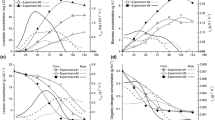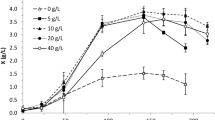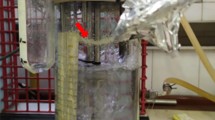Abstract
Little information is available in the literature concerning the kinetics of the production of exopolysaccharides (EPS). The kinetics of growth, substrate consumption and lasiodiplodan (LAS) production by the filamentous fungus Lasiodiplodia theobromae MMPI were studied in a new bioreactor design (Low-Shear Aerated and Agitated Bioreactor; LSAAB) using media based on glucose and glycerol. The kinetic parameters of cultivation were compared with fermentations conducted in a stirred tank bioreactor (STR) and in shake flasks. Cultivation in LSAAB using glucose resulted in 3.17 ± 0.16 g.L−1 of LAS, a value lower than that obtained in shake-flasks (6.49 ± 0.03 g.L−1), but somewhat higher than obtained in STR (0.70 ± 0.12 g.L−1). When glycerol was used as substrate, the production of LAS was less effective than glucose. From the fungal biomass produced, as well as the related growth kinetic parameters (YX/S and QX), fungal growth was more efficient in LSAAB. Lasiodiplodan production by L. theobromae MMPI from glycerol was accelerated by an increase in broth pH during cultivation, and the behavior was opposite (decreased pH) when using glucose. LSAAB proved to be promising for the production of LAS by the fungus studied. Although glucose was shown to be the better substrate for the production of LAS, glycerol, as a fermentation substrate, has potential of a less-expensive medium for cultivating the fungus.





Similar content being viewed by others
References
Thombare N, Jha U, Mishra S, Siddiqui MZ (2016) Guar gum as a promising starting material for diverse applications: a review. Int J Biol Macromol 88:361–372. https://doi.org/10.1016/j.ijbiomac.2016.04.001
Kumar A, Rao KM, Han SS (2018) Application of xanthan gum as polysaccharide in tissue engineering: a review. Carbohydr Polym 180:128–144. https://doi.org/10.1016/j.carbpol.2017.10.009
Nagi M (2018) Global Biopolymers market to witness a CAGR of 15.2% during 2018–2024: Energias market research Pvt. Ltd. https://www.globenewswire.com/news-release/2018/07/11/1535796/0/en/Global-Biopolymers-Market-to-witness-a-CAGR-of-15-2-during-2018-2024-Energias-Market-Research-Pvt-Ltd.html. Accessed 17 Dec 2019
Baldassano S, Accardi G, Vasto S (2017) Beta-glucans and cancer: the influence of inflammation and gut peptide. Eur J Med Chem 142:486–492. https://doi.org/10.1016/j.ejmech.2017.09.013
Bozbulut R, Sanlier N (2019) Promising effects of β-glucans on glycemic control in diabetes. Trends Food Sci Technol 83:159–166. https://doi.org/10.1016/j.tifs.2018.11.018
Han F, Fan H, Yao M et al (2017) Oral administration of yeast β-glucan ameliorates inflammation and intestinal barrier in dextran sodium sulfate-induced acute colitis. J Funct Foods 35:115–126. https://doi.org/10.1016/j.jff.2017.05.036
Orlandelli RC, Corradi da Silva M, de L, Vasconcelos AFD, et al (2017) β-(1→3,1→6)-D-glucans produced by Diaporthe sp. endophytes: Purification, chemical characterization and antiproliferative activity against MCF-7 and HepG2-C3A cells. Int J Biol Macromol 94:431–437. https://doi.org/10.1016/j.ijbiomac.2016.10.048
Bohn JA, BeMiller JN (1995) (1→3)-β-D-Glucans as biological response modifiers: a review of structure-functional activity relationships. Carbohydr Polym 28:3–14. https://doi.org/10.1016/0144-8617(95)00076-3
Grand View Research (2020) Beta-glucan Market Size, Share & Trends Analysis Report By Source (Cereal, Mushroom, Yeasts, Seaweed), By Application (F&B, Personal Care, Pharmaceuticals, Animal Feed), By Type, By Region, And Segment Forecasts, 2018 - 2025. https://www.grandviewresearch.com/industry-analysis/beta-glucan-market. Accessed 17 Jun 2020
Osińska-Jaroszuk M, Jarosz-Wilkołazka A, Jaroszuk-Ściseł J et al (2015) Extracellular polysaccharides from Ascomycota and Basidiomycota: production conditions, biochemical characteristics, and biological properties. World J Microbiol Biotechnol 31:1823–1844. https://doi.org/10.1007/s11274-015-1937-8
Kagimura FY, Da Cunha MAA, Theis TV et al (2015) Carboxymethylation of (1→6)-β-glucan (lasiodiplodan): preparation, characterization and antioxidant evaluation. Carbohydr Polym 127:390–399. https://doi.org/10.1016/j.carbpol.2015.03.045
Decho AW (1990) Microbial exopolymer secretions in ocean environments: their role(s) in food webs and marine processes. Oceanogr Mar Biol Ann Rev 28:73–153
Sutherland IW (1979) Microbial exopolysaccharides. Trends Biochem Sci 4:55–59. https://doi.org/10.1016/0968-0004(79)90262-7
Vasconcelos AFD, Monteiro NK, Dekker RFH et al (2008) Three exopolysaccharides of the β-(1→6)-D-glucan type and a β-(1→3;1→6)-D-glucan produced by strains of Botryosphaeria rhodina isolated from rotting tropical fruit. Carbohydr Res 343:2481–2485. https://doi.org/10.1016/j.carres.2008.06.013
Úrbez-Torres JR, Leavitt GM, Guerrero JC et al (2008) Identification and pathogenicity of Lasiodiplodia theobromae and Diplodia seriata, the causal agents of bot canker disease of Grapevines in Mexico. Plant Dis 92:519–529. https://doi.org/10.1094/PDIS-92-4-0519
Fesel PH, Zuccaro A (2016) β-glucan: Crucial component of the fungal cell wall and elusive MAMP in plants. Fungal Genet Biol 90:53–60. https://doi.org/10.1016/j.fgb.2015.12.004
Corradi da Silva M, de L, Fukuda EK, Vasconcelos AFD, et al (2008) Structural characterization of the cell wall D-glucans isolated from the mycelium of Botryosphaeria rhodina MAMB-05. Carbohydr Res 343:793–798. https://doi.org/10.1016/j.carres.2007.12.021
Cunha MAA, Turmina JA, Ivanov RC et al (2012) Lasiodiplodan, an exocellular (1→6)-β-D-glucan from Lasiodiplodia theobromae MMPI: Production on glucose, fermentation kinetics, rheology and anti-proliferative activity. J Ind Microbiol Biotechnol 39:1179–1188. https://doi.org/10.1007/s10295-012-1112-2
Seviour RJ, Stasinopoulos SJ, Auer DPF, Gibbs PA (1992) Production of pullulan and other exopolysaccharides by filamentous fungi. Crit Rev Biotechnol 12:279–298. https://doi.org/10.3109/07388559209069196
Abad S, Turon X (2012) Valorization of biodiesel derived glycerol as a carbon source to obtain added-value metabolites: Focus on polyunsaturated fatty acids. Biotechnol Adv 30:733–741. https://doi.org/10.1016/j.biotechadv.2012.01.002
Seviour RJ, McNeil B, Fazenda ML, Harvey LM (2011) Operating bioreactors for microbial exopolysaccharide production. Crit Rev Biotechnol 31:170–185. https://doi.org/10.3109/07388551.2010.505909
Prata AMR, Ferraz AL, Domingos M, Silva Junior JM, 2011. Biorreator com sistema de agitação e aeração específico para cultivo de células aderentes e/ou sensíveis ao cisalhamento. BR Patent PI 1003119–7I.
Domingos M, de Souza-Cruz PB, Ferraz A, Prata AMR (2017) A new bioreactor design for culturing basidiomycetes: mycelial biomass production in submerged cultures of Ceriporiopsis subvermispora. Chem Eng Sci 170:670–676. https://doi.org/10.1016/j.ces.2017.04.004
Saldanha RL, Garcia JE, Dekker RFH et al (2007) Genetic diversity among Botryosphaeria isolates and their correlation with cell wall-lytic enzyme production. Brazilian J Microbiol 38:259–264. https://doi.org/10.1590/S1517-83822007000200013
Vogel HJ (1956) A convenient growth medium for Neurospora crassa. Microbial Genet Bull 13:42–43
Steluti RM, Giese EC, Piggato MM et al (2004) Comparison of Botryosphaeran production by the ascomyceteous fungus Botryosphaeria sp., grown on different carbohydrate carbon sources, and their partial structural features. J Basic Microbiol 44:480–486. https://doi.org/10.1002/jobm.200410415
Miller GL (1959) Use of dinitrosalicylic acid reagent for determination of reducing sugar. Anal Chem 31:426–428. https://doi.org/10.1021/ac60147a030
Dubois M, Gilles KA, Hamilton JK et al (1956) Colorimetric method for determination of sugars and related substances. Anal Chem. https://doi.org/10.1021/ac60111a017
Bradford MM (1976) A rapid and sensitive method for the quantitation of microgram quantities of protein utilizing the principle of protein-dye binding. Anal Biochem 72:248–254. https://doi.org/10.1016/0003-2697(76)90527-3
Jarman TR, Pace GW (1984) Energy requirements for microbial exopolysaccharide synthesis. Arch Microbiol 137:231–235. https://doi.org/10.1007/BF00414549
Nampoothiri KM, Singhania RR, Sabarinath C, Pandey A (2003) Fermentative production of gellan using Sphingomonas paucimobilis. Process Biochem 38:1513–1519. https://doi.org/10.1016/S0032-9592(02)00321-7
Torres CAV, Marques R, Ferreira ARV et al (2014) Impact of glycerol and nitrogen concentration on Enterobacter A47 growth and exopolysaccharide production. Int J Biol Macromol 71:81–86. https://doi.org/10.1016/j.ijbiomac.2014.04.012
Lazaridou A, Roukas T, Biliaderis CG, Vaikousi H (2002) Characterization of pullulan produced from beet molasses by Aureobasidium pullulans in a stirred tank reactor under varying agitation. Enzyme Microb Technol 31:122–132. https://doi.org/10.1016/S0141-0229(02)00082-0
Barroso CB, Nahas E (2005) The status of soil phosphate fractions and the ability of fungi to dissolve hardly soluble phosphates. Appl Soil Ecol 29:73–83. https://doi.org/10.1016/j.apsoil.2004.09.005
Mahapatra S, Banerjee D (2013) Fungal exopolysaccharide: production, composition and applications. Microbiol Insights 6:1–16. https://doi.org/10.4137/mbi.s10957
Giese EC, Dekker RFH, Scarminio IS et al (2011) Comparison of β-1,3-glucanase production by Botryosphaeria rhodina MAMB-05 and Trichoderma harzianum Rifai and its optimization using a statistical mixture-design. Biochem Eng J 53:239–243. https://doi.org/10.1016/j.bej.2010.10.013
Acknowledgements
The authors thanks to Universidade de São Paulo (USP) and Coordenação de Aperfeiçoamento de Pessoal de Nível Superior (CAPES) for providing financial support.
Author information
Authors and Affiliations
Corresponding author
Ethics declarations
Conflict of interest
The authors declare no conflict of interest.
Additional information
Publisher's Note
Springer Nature remains neutral with regard to jurisdictional claims in published maps and institutional affiliations.
Electronic supplementary material
Below is the link to the electronic supplementary material.
Rights and permissions
About this article
Cite this article
Tabuchi, S.C.T., Martiniano, S.E., Cunha, M.A.A. et al. Kinetic Study of Lasiodiplodan Production by Lasiodiplodia theobromae MMPI in a Low-Shear Aerated and Agitated Bioreactor. J Polym Environ 29, 89–102 (2021). https://doi.org/10.1007/s10924-020-01857-x
Published:
Issue Date:
DOI: https://doi.org/10.1007/s10924-020-01857-x




